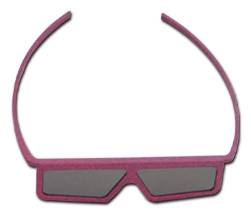



| Polarized 3D glasses create the illusion of
three-dimensional images by restricting the light that reaches
each eye, an example of stereoscopy. To present a stereoscopic
motion picture, two images are projected superimposed onto the
same screen through orthogonal polarizing filters. The viewer
wears low-cost eyeglasses which also contain a pair of
orthogonal polarizing filters. As each filter only passes light
which is similarly polarized and blocks the orthogonally
polarized light, each eye only sees one of the images, and the
effect is achieved. The difficulty arises because light reflected from a motion picture screen tends to lose a bit of its polarization. However, this problem is eliminated if a 'silver' or Aluminized screen is used. This means that a pair of aligned DLP projectors, some polarizing filters, a silver screen, and a computer with a dual-head graphics card can be used to form a relatively low-cost (under US$10 000 in 2003) system for displaying stereoscopic 3d data simultaneously to tens of people wearing polarized glasses. Such a system, called a GeoWall, has been used for several years now in the Earth Sciences thanks to the GeoWall Consortium, with several open source and commercial packages available. When stereo images are to be presented to a single user, it is practical to construct an image combiner, using partially silvered mirrors and two image screens at right angles to one another. One image is seen directly through the angled mirror whilst the other is seen as a reflection. Polarised filters are attached to the image screens and appropriately angled filters are worn as glasses. A similar technique uses a single screen with an inverted upper image, viewed in a horizontal partial reflector, with an upright image presented below the reflector, again with appropriate polarizers. Polarizing techniques are most simply used with cathode ray technology, as polarizers are used within ordinary LCD screens for control of pixel presentation - this can interfere with these techniques. In 2003 Keigo Iizuka discovered an inexpensive implementation of this principle on laptop computer displays using cellophane sheets. Polarized 3D Motion Pictures have been around since the middle of the 20th century. The so called "3D movie craze" in the years 1952, through 1955 was mostly offered in theaters using polarizing projection and glasses. Only a minute amount of the total 3D films shown in the period used the anaglyph color filter method. What is new is the use of digital projection, and also the use of sophisticated IMAX 70mm film projectors, with very reliable mechanisms. A whole new generation of 3D animation films are beginning to show up in the theaters, all using some form of polarization. Polarization is not easily used for home 3D tv or DVD presentation. At this point only anaglyph glasses, paper or plastic can be used to view the new HD shows at are beginning to be aired occasionally by NBC and the Discovery Channel. Need something custom like the designs below! Just give us a call!
Stock Design available for order below
Plastic Polarized Glasses- Standard recyclable amusement park glasses. Linear polarized film mounted at opposing 45 degree angles used by Disney Theme Parks, Imax Theaters and Universal Studios. Stock Design available for order below
|
Need Custom Printed
3D Glasses?? Contact Rainbow Symphony, Inc. Toll Free
800-821-5122 Ph# 818-708-8400 Fax# 818-708-8470
rainbowsymphony@rainbowsymphony.com
Copyright 2006 3D Glasses Direct. All rights reserved

